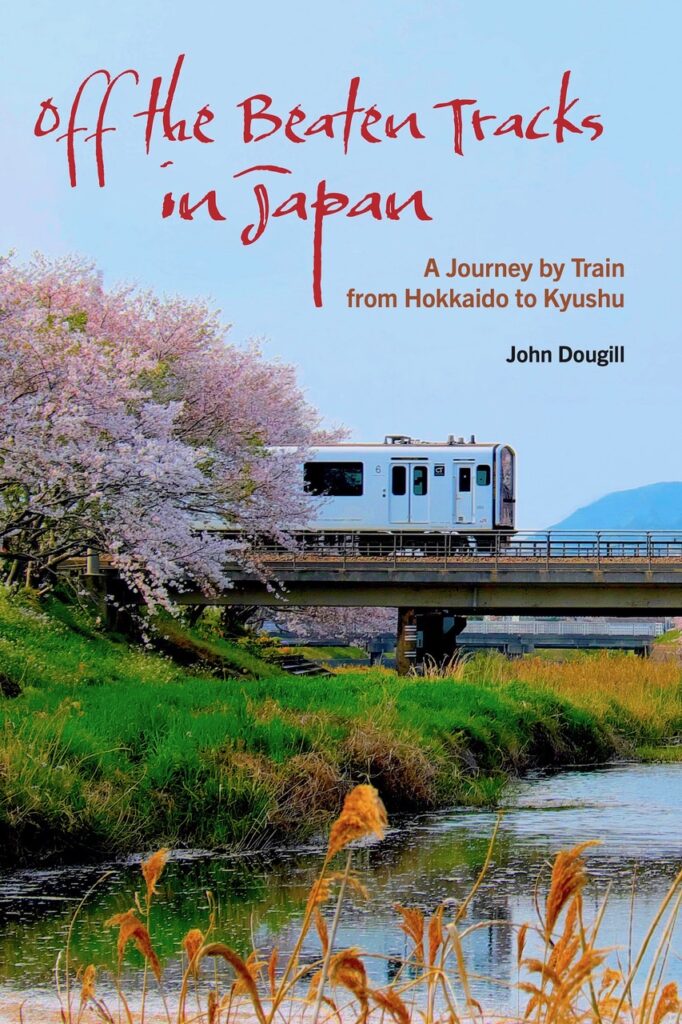Recently I reviewed a travel book by Alex Kerr, Hidden Japan (Tuttle, 2023), and in that review I extolled the virtues of “armchair travel” (traveling in one’s imagination instead of physically). At the same time as I was writing that review, I was also reading John Dougill’s Off the Beaten Tracks in Japan (Stonebridge Press, 2023), which I would also recommend as an excellent “armchair travel” book. These two books will be forever coupled in my mind. They are very different in content and in organization, but they are both invitations to read about, rather than run off and visit, out-of the-way spots in Japan.
The title is “Off the Beaten Tracks” rather than the more usual form of the expression, “off the beaten track.” I inferred that the author was calling attention to his journey, which was by train, on train tracks. At the same time, the trains he took, from the northernmost point of Hokkaido to the southernmost point of Kyushu, were on the Japan Sea coast rather than the more populous and better known Pacific side (the left side rather than the right of the Japanese archipelago if one looks at a map). In this sense, the trains he took were indeed “off the beaten tracks” and on less well-known ones.
However, this is not a train buff’s guide. The trains themselves are rather unobtrusive, except for a small historical note at the end of each chapter giving interesting details about the various lines. Actually, Dougill frequently parted company with the train tracks, using branch lines or other forms of transport, in order to visit sites not on them. However, the peculiarly Japanese feel of train travel, clean, quiet and on time, which seems to be enough to induce a meditative state, especially on slower trains, is always present. This interior-looking mood pervades the book, even when the author is not traveling.
The author makes no bones about this not being an ordinary guidebook. In the Preface he writes, “This is not a conventional travel guide… my journey draws rather on over thirty years of cultural immersion to give a personal account of the fascination that Japan holds for foreigners.” Elsewhere he cites the saying that if one wants to write about Japan, one should do so after three weeks or thirty years. Long-term residents of Japan, giving this saying some thought, would probably agree. In between, a lot of forgetting and a lot of learning happens.
This is indeed a deeply personal book. The author tells us about his father’s occupation as a vet leading to a lifelong love of animals, his long-term partnership with a Kyoto woman, and of course his fascination with Japan, based on decades of astute observation, always shines out. This quality of careful observation is enough to make the most jaded and cynical Japan resident fall in love all over again, in a sort of “Hey, I had forgotten about that” way.
John Dougill is following in some illustrious footsteps. He cites many foreign travelers who have covered some of the same ground, including Alan Booth, author of The Roads to Sata (Penguin, 2021), Isabella Bird, the first foreign woman to travel alone in Japan, Ranald MacDonald, who came from Canada to Hokkaido and then to Nagasaki, where he became arguably the first English teacher in Japan, and several others.
His eye rests on many fascinating things on his travels, but he never forgets to include down-to-earth pleasures such as details of memorable meals, hot spring visits, barefoot treks across beach stones, etc. He also gives many interesting historical vignettes, not only remote history but also more recent historical landmarks, such as the racial discrimination case that started in an Otaru bathhouse in the 1990s.
I learned many things by reading this book and was not too tempted to put some of the places as “must-sees” on my personal itinerary. But one place I have never visited, and now thanks to Dougill’s expertise and love of Shinto, I now consider a “must-see”, is the shrine of Izumo in Shimane Prefecture. I knew that October was called “the month of no gods” (kannazuki) but I did not know that this is because the gods of Shinto visit Izumo during this month from all over Japan, resulting in this month being called “the month with the gods” (kamiarizuki) in Izumo. The author was once privileged to see the ceremony welcoming the gods to Izumo at a nearby beach. This description alone made the book worth the read for me.
The book is divided into five sections, and these divisions are easy to see, thanks to the grey pages introducing them. Each section has a map at the beginning showing the places Dougill visited, and there is also a map showing the entire route. There are also photos of places and things touched on in the text.
Off the Beaten Tracks in Japan is another book that argues for a return to “armchair travel” and an avoidance of the well-known (some would say too well known) tourist spots, in favor of a heartwarming personal account of a life spent exploring Japan, with a background of trains clacking serenely through the landscape.
* * *
John Dougill is the founder of Writers in Kyoto, author of numerous books on Japan including Japanʼs World Heritage Sites (Tuttle, 2014), In Search of Japanʼs Hidden Christians (Tuttle, 2012) and Kyoto: A Cultural History (Signal/OUP, 2004). He also runs the Green Shinto blog. A longer introduction can be found here, and a listing of his available books here.

